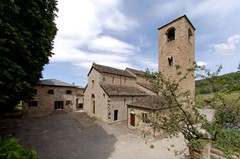Montefiorino.
The Parish Church of Rubbiano. Poggio Medola
Our journey continues along the valley of the Dolo and Dragone streams, a place of unspoilt nature, enriched by an ultra-millennial history which has left behind countless monuments and other remains.
In the little hamlet of Rubbiano, not far from Montefiorino, in the middle of truly stunning countryside, we find the Parish Church of Santa Maria Assunta, with its harmonious Romanesque proportions almost intact.
This is quite possibly one of the oldest churches in the territory of Modena, dating back to the 12th century, and lying on the Via Bibulca, a main thoroughfare in the Middle Ages.
For many centuries the Church of Rubbiano was of great importance, both on the spiritual plane as a mother church and provider of baptisms, and on the temporal plane as administrator of a vast territory and various minor churches and oratories. Its temporal power began to dwindle however with the founding of the Abbey of Frassinoro commissioned by Beatrice of Lorraine, Matilda of Canossa’s mother.
There are various theories about when the existing building was constructed: some scholars recognize its style as belonging to Matilda’s times, inspired by the architectural canons of Cluny, others date it to around 113o, the period of maximum importance for the Modena-based school of Lanfranco, the architect of Modena’s magnificent cathedral, currently a UNESCO World Heritage Site.
Let’s have a look at the church’s architecture. The simple façade, reconstructed after the church was shortened by one or two arches for reasons of stability, features a splayed portal and a small twin-lancet window with binary columns. Passing under the small arched entrance that connects the church to the recently restored parsonage, we enter a small square which lies at a lower level and from which we can admire the perfect masonry of the left-hand side, consisting of large, finely squared-off ashlars laid in strict parallel rows.
The splendid, evenly faced apses are cleanly separated from one another and arranged in scalar fashion, that is to say, with the median protruding. Of note are the sculptures, partially reworked, the capitals and semi-columns, and the ledges that support the small arches and lunettes featuring vegetal and zoomorphic motifs as well as human figures. Next to the church rises the striking belltower, probably erected in the Romanesque era with the belfry added in the Baroque period.
Inside, the harmonious architectonic structure is embellished by the ornamental motifs of the column capitals, two of which are neo-Corinthian in style. Of note is the small sculpture of two lions snapping at one another on the capital of the semi-column behind the right-hand column. The holy water stoup is splendid too: decorated with four finely carved female figures with the body of a winged siren and the legs of a harpy. Sitting atop a Doric capital from a column sitting outside, some scholars attribute it to the Master of the Metope, the artist who sculpted the metope in Modena cathedral, others to the school of Wiligelmus, both active in the eleventh to twelfth century.
Poggio Medola
In the median part of the Dragone valley sat the Corte di Medola, perched on a serpentine rocky cliff where an imposing fortress rose.
A fortified site, already mentioned in 1071 amongst the possessions of Frassinoro Abbey, this was the scene of bitter struggles and repeated attacks by the Commune of Modena.
Handed over to the city of Modena in 1278, it was taken by force by Guidinello da Montecuccoli and remained in the family’s hands until the 16th century. Of the castle complex all that remains is the recently restored ancient cistern to collect rainwater, together with an ancient ice-house and the courtyard of the small village, at the foot of the cliff.
From a naturalistic point of view, Poggio Medola and the nearby 788m high Rupe del Calvario, along with Poggio Bianco Dragone and the Cinghio del Corvo, situated in front on the other bank of the Dragone stream represent the most striking ophiolite complex in the Modena stretch of the Apennines.
